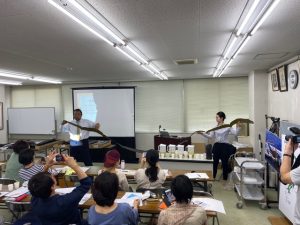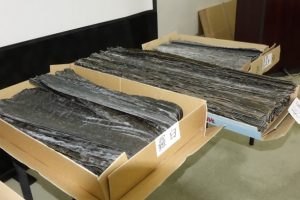Mr. Atsutaka Kitajō gave a talk on the theme of "Konbu full of mysteries? You don't really understand kelp, do you?"
Kombu has a long history. At the end of the Jomon period, people who came to Japan from the Jiangnan region of China, living on ships, did not use kombu as food, trade with the continent, or use it as a gift to rulers. It is said that
?
Kombu is deep5?7mIt grows by photosynthesis in the sea.size is length2mfrom about10mThere are more.
1Older kombu wilts.It grows again from the remaining root part and becomes delicious kombu, which is harvested for food.
?7From the moon9The month is the season for kelp fishing (Hokkaido in winter is too cold to do so).!).
1person2It is a small, manned boat that uses tools such as hooks with long handles and bifurcated poles to collect the kombu seaweed, similar to wrapping pasta with a fork.
The harvested kombu is dried in a drying field covered with pebbles.
?
Kombu is a kind of seaweed that grows in cold seas, and about XNUMX% of edible kelp90%is from Hokkaido.There are differences depending on where it is harvested.
・Rishiri kelp is a little firmer than makombu.It produces a clear and flavorful broth, which is used in kaiseki cuisine.
・Rausu kelp is a luxury product on par with makombu.When the dashi is taken out, it becomes cloudy, but it produces a fragrant and full-bodied dashi.Due to its unique stickiness, it is processed into grated yam, oboro, and Matsumae pickles.
・Hidaka kelp is delicious, soft and easy to cook.It is suitable for dashi kelp, kombu rolls, and boiled kelp for general household use.
・Makombu is thick and wide, and is a luxury product of kelp.It is used for high-quality nadashi, salted kombu, and exquisite oboro, and is also used for decorations such as betrothal gifts.
Many kinds of kelp were lined up in large quantities at the venue, and we were able to touch, smell, and ask questions.
After tasting the kombu dashi made by Mr. Kitajo, we tasted the pasta with a tomato sauce made from kombu dashi and dried tomatoes.It seems that the compatibility of tomatoes and kelp is very good.
At this study group, we could feel Mr. Kitajo's passion for passing on the traditional Japanese kelp food culture to the next generation.
?
■An article about this workshop will be published in the February issue of Musubi magazine.
Osaka Konbu Kaisan HP
Types of kelp and recipes are posted
http://osakakombu.jp/